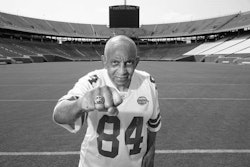CLEMSON, S.C.
When the final whistle blew, the scoreboard in Death Valley read Clemson 54, South Carolina State 0, but on this Saturday in late September, there was more than a football game being played.
It wasn’t just a game, it was history with bloodlines. There were friends and fellowship, some rich and some poor, and, most importantly, there was Clemson University, a public land-grant school creating opportunities to become more diverse academically and athletically by establishing a partnership on more than one front with a historically Black college.
It was the first meeting between Clemson and its sister school from Orangeburg, S.C., which is only in existence because of the state’s flagship university’s inability to diversify enrollment over a century ago.
“This game displays racial good will for the state,” said Dr. Louis Lynn, a Clemson trustee. “We are not where we need to be yet with interracial relations, but the game allowed us to make contacts within the two universities. In America there is no better ice-breaker than a college football game.”
The History
Founded as a land-grant college in 1889 following the passage of the Morrill Act (1862), Clemson’s mission was to establish a “high seminary of learning” through its historical land-grant responsibilities of teaching, research and extended public service.
But this education was only to be obtained by Whites. And, with the passing of the Second Morrill Act (1890), Clemson like all other existing land grant colleges, was ordered to make no distinctions in race for admission purposes. If they did discriminate, the state of South Carolina, like many other southern states, would be forced by legislation to offer equal opportunity to Black students and open a land-grant funded university.
Established in 1896, South Carolina State University has shared nearly the same mission statement as its sister school, Clemson, but for the Black community, which represents nearly 29 percent of the state’s 4.5 million residents. Over 16 percent more Blacks live in the state of South Carolina than the national average. Only five other states have more Blacks than the Palmetto state.
“We all appreciate diversity, and our demographics at S.C. State are even changing,” said Dr. George E. Cooper, the university’s president. “Clemson, however, is a latecomer to diversity.”
“If you look at the history of the universities, the sponsors of the legislation recognized that land-grant colleges were not offering education to the masses, who happened to be African-American students following the Civil War. The Morrill Act of 1890 was set out to allow African-Americans a chance to enroll at the same university, not create HBCUs [historically Black colleges and universities].
“The good news is, now [Clemson] is incorporating numerous programs to address the issues of diversity.”
Working Together
On Saturday, Clemson continued its quest to create a more diverse institution, trying to remove the black eye that history placed on much of the southern states because of segregation and slavery.
In rooting his Tigers to victory, James F. Barker also had an agenda. The Clemson president was busy promoting one of his prize programs of diversity, Call Me MISTER.
MISTER, an acronym for Mentors Instructing Students Toward Effective Role Models, encourages Black male college students to become teachers so they can enter classrooms in the state and become role models for students.
“Less than 1 percent of all teachers in the state of South Carolina are African-American males,” said Dr. Roy Jones, Call Me MISTER project director. “Our program is set out to change that.”
“This game gave us a chance to meet with one of our collaborating universities [SC State] who does an excellent job educating Black males. We also had Ulysees Gilbert II, the project manager in Florida at the game. With this addition to our program, we will have expanded across six states by next year,” Jones said.
Through his diversity program, One Clemson, president Barker has set out to educate students so they can respect different cultural and racial backgrounds. Barker has also established the Best Practices Conference for Black Student Achievement.
“Clemson has really garnered (a reputation) as the place to bring your Black students if you want them to be recognized,” said Barker. “To tie into the flavor of the game, South Carolina State University has been a part of [the Best Practices Conference] from day one.”
“I don’t think you can separate athletics and academics at any university, because they mesh and intertwine across so many different paths and are each important in their own way.”
Sen. Lindsey Graham, R-S.C, was also present at Saturday’s contest to be a part of history and noted that this game needed to happen. On an education standpoint, the two universities have done so much together that it was time to “break ice” on the field, said Graham.
Football is king in South Carolina, and it has the potential to bring together people of all backgrounds.
Skewed by the wealthy northeastern transplants along the coast and the rich agricultural history in the upstate, 15 percent of the residents in the state live in poverty, a statistic higher than the national average.
“I want to thank Clemson for making this game possible, because it is a big, big deal for South Carolina State,” said Graham. “This game will help South Carolina State in every facet of their endeavors.
“It helps in recruiting sports-wise. They will get a good gate receipt here today, and it showcases the great talent that exists academically and musically at their campus. It’s just overall a good game for the state of South Carolina.”
Graham has also been active in helping create diversity in South Carolina’s work force. And, according to Graham, that starts with higher education.
“I have created a historically Black college job fair,” Graham said. “My goal is to make sure that the best and the brightest of the African-American college students in South Carolina never leave the state unless they want to.”
“I want to try to create an environment so that they can stay here and give them the chance to work with the major companies in South Carolina and federal agencies that are hiring.”
The Game
With plenty of action already taking place in the first half [30-0 in favor of Clemson], 78,000 fans remained in their seats to see something special ¯ some for the first time. Although the football team suffered its worst loss in eight years and fell to 0-4 against subdivision opponents, SC State’s band, “The Marching 101,” showed during halftime why it is unbeaten in its competitions.
Like Grambling State University and Southern University at Baton Rouge, SC State’s band has more oomph than your everyday marching band.
“Y’all won the battle of the bands,” said Clemson trustee Lynn at halftime to nearly a dozen of his S.C. State guests in the Clemson Trustee Box.
Clemson fans gave the 101 performers a standing ovation that nearly copied a Tiger touchdown ovation.
It is highly unlikely the athletes of the new millennium paid any attention to the historical context of Saturday’s celebration of integration. Nor is it certain they care.
“It’s not the first thing I think about, but I have to go back and realize that there were people before me that paved the road I am walking on now,” said Clemson defensive lineman, Dorell Scott, a Columbia, S.C., native.
Since day one, Clemson rejected admission applications from Black students. In 1963, Harvey Gantt became the first African-American to attend Clemson after being admitted through a court order, setting up many latent effects, including athletic opportunities for Blacks at traditionally White schools like Clemson.
“I think athletics is moving along with the general society when it comes to integration and the notion of everyone is created equal,” said Clemson head football coach Tommy Bowden. “There is no doubt that recruiting opportunities have increased because of this.”
The Payout
Although many issues were addressed when these two teams met at Memorial Stadium last weekend, the game was truly about money.
S.C. State traded a 54-point loss for $235,000 to add to its athletic budget, according to athletic director Charlene Johnson. The S.C. State Bulldogs also received close to $250,000 following a first-week loss at Central Florida. More money was received from UCF because of greater travel costs than the 170 mile gaunt across South Carolina.
“There is no excuse to make money, because, after all, this is a business,” said Dr. James Ogelsby, a graduate of S.C. State. “But this game adds a piece to the puzzle that was missing between these two universities. South Carolina State took the grand stage at Clemson and showed that there is football being played in Orangeburg, and also gave Clemson fans a great show at halftime with our excellent band.”
Coach Bowden also noted that he has always been in favor of keeping the money in the state of South Carolina when it comes to playing football championship subdivision schools like S.C. State.
“Just recently, South Carolina State started stepping out of playing historically Black colleges in out-of-conference games, and began playing Division I opponents,” said Bowden. “We wanted to make sure that we included them in our scheduling, keeping the money in the state like we do with Wofford [College], Furman [University] and The Citadel.”
“I think once [head football] coach [Buddy] Pough accepted the opportunity to play us, it just showed how far our cultures have come in a southern state like South Carolina.”
Besides the University of South Carolina playing the State Bulldogs a year ago, no other HBCU has received a gracious pay-out from its in-state sister after agreeing to meet on the gridiron.
“I’m not so sure that we set out to do something radical by playing this game,” said Clemson president Barker. “I think it seemed a natural evolution with what is going on in our state.”
So can this be an eye-opener for the rest of college football?
“I’m hopeful but pessimistic that it will,” said Lynn. “[HBCUs] don’t have the fan base. There are some natural reasons why if you look at football as an enterprise. There is reason not to do it.”
Email the editor: [email protected]
Click here to post and read comments
© Copyright 2005 by DiverseEducation.com


















